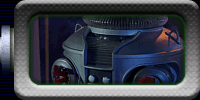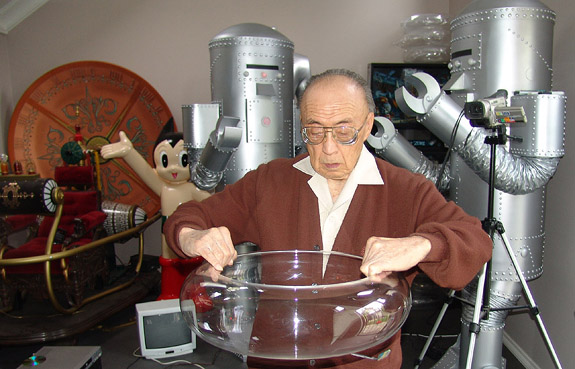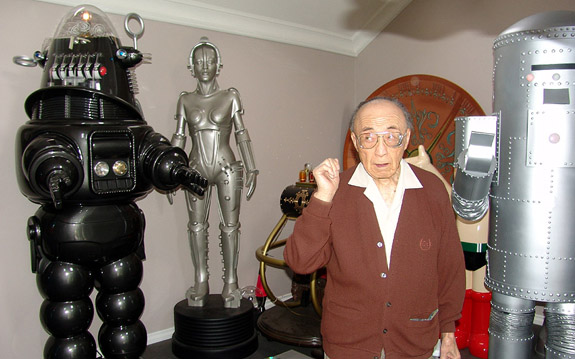




 |
|
| Home->Heart & Soul: Robert Kinoshita | |||
Died: December 9, 2014 (age 100) in Torrance, California, USA
A personal message from Mr. Kinoshita to our club: Thank you, thank you, thank you! I'm truly flabbergasted and honored by your support for "Blinky"! It's a well designed little beauty! I shall really cherish it!
Mike Clark tells me your group is doing an accurate and masterful job reproducing "Blinky"! That's terrific! More power to you and your group! In
sincere appreciation... and thanks again with all of my heart!
Bob Kinoshita- May 14, 2000
Here are some photos taken at Bob's 94th Birthday Party held January 26th, 2008 On Saturday
night, January 26th, Bob Kinoshita was joined by several B9ers and
friends to celebrate his 94th birthday.
Several
club members were able to attend, a great time was had by all!
The
following is an interview of Bob Kinoshita conducted by ICONs back
in 1998. B-9 Robot Bob Kinoshita Interview. A Conversation With Bob Kinoshita, Lost In Space B9 Robot Designer BOB KINOSHITA is known as the designer of two of the best-known Robot characters in science fiction...Robby the Robot from Forbidden Planet, and the B9 Robot from Lost in Space. Kinoshita worked with production designer Bill Creber on the Lost in Space pilot, and was later promoted to series art director when the show was sold to CBS. At that time, it was decided to add another deck to the Jupiter II spacecraft, and create a Robot character. ICONS spoke with Kinoshita briefly about his involvement with Lost in Space. ICONS: How many designs did you go through before the Robot became the character as we know it? BOB KINOSHITA: It took about six designs...a bunch of little rough sketches and ideas. You're laying in bed, and something comes to you. Until finally, you get to a point where you say "this could work," OK, let's see what the boss man says and you present it to him. ICONS: How long did it take to complete the Robot...from initial design to finished prop? KINOSHITA: I think it only took me six weeks, because I had a bunch of people. They were always shifting people in the art department. After a while, they became numbers...something to trade somebody else with...it's like a baseball team, you trade the ones you don't want. At one time I had 14 people working for me. ICONS: When you designed the Robot was it with a person in mind? KINOSHITA: First we were trying to do it without anyone in there because we knew it was dangerous. At any moment it could stop or trip wherever and inside there is all kinds of stuff that he could get hurt on.There was a yellow cord running up the back of the Robot that held 2,000 volts. ICONS: How was the decision made to have a man inside the costume? KINOSHITA: There was more talk about not having a Robot operator, because that would save the cost of another actor. But it was harder to manipulate theRobot on command if there wasn't a human operator. Plus the idea was the guy inside operating would give it personality. Bob clowns around with his old friend during a recent visit to the ICONS Robot Factory. ICONS: In this case, Bob May. Can you tell us how Bob contributed to the character? KINOSHITA: Bob had a tough time in there, but he did a great job. He used the things we built in very well. The Robot's head itself can have it's own gesture or expression. The side things, which are his range finders,and the inside mechanism and the electronic stuff are all used to create a character. It's just like the old shortwave operators...each man has his own mannerism of hitting the key, and that's the same thing with the guy inside the suit. Bob would operate with responses...when he hears a noise, he responds in a certain way to the noise, by moving the bubble up "hey what's that?" or down, or turning the body, or retracting his arms, or letting the arms go limp. That will give him a little personality. The sets were so hot at the time I used to pity Bob inside that suit. ICONS: What is the most difficult aspect of creating a Robot character for television? KINOSHITA: Movement is the hardest thing to accomplish. How to move this thing. The guys who were manipulating were part of the special effects department, and they figured out a way to make it turn a corner quickly...and they had this cable system where it would go to a certain point, then they would hit this "release" and then the Robot would pull another way. Almost a u-turn. Also, the Robot could walk or motivate himself with the treads. Because each leg was independent. A lot of directors didn't know what to do with the Robot on set. How to use it. And then there were others who knew exactly how to use it very well. ICONS: Were there any problems that you could not overcome. KINOSHITA: When the Robot stops or goes, there's a "sway," you can't help it because there's a guy in there. That was hard to overcome...it was practically impossible because the man himself is in such a confined space, and his platform where he's standing on is the size of his foot. Anytime you made that motion to start or stop him...he'd move. Also, the rubber "pants" of the Robot didn't come out of the mold very well...they were kind of crinkled in appearance. We re-did them later in the season. ICONS: What was Irwin Allen's input on the designs? KINOSHITA: He'd either say he liked it or didn't like...that was about it. If he didn't like it, he wouldn't quite say what he didn't like, but I knew maybe he didn't like a certain look, or the total wasn't what he was looking for. It was trial and error. ICONS: Since you were the main designer (along with MGM's Arthur Lonergon) on Robby the Robot, a lot of people notice a similarity with the Lost in Space Robot. KINOSHITA: I'm the designer of both of them, so you know, naturally, I get some things similar. ICONS: Since the Robot has no real "eyes" or "mouth," what device serves those purposes? KINOSHITA: Those "ear" things. The two would put a beam out and it would focus on something. It's like a sighting system on an aircraft...the two receptors give two points on the aircraft...and that gives them the range. So the Robot's eyes are those two rotating receptors below the bubble. ICONS: Speaking of the bubble...it must have been incredibly difficult to create that shape from plexiglass. Where did you learn to do it? KINOSHITA: I
used to be a designer right after the war at the Clever Brooks Company.
They were designing equipment for the armed forces. This is where
I learned to cast and form plastics. Forming the bubble could be
dangerous, because if you get a flaw in the plastic, and you heat
ICONS: Because of a limited series budget, it seemed to recycle a lot of props and sets on Lost in Space. Can you tell us about that? KINOSHITA: There was a junkpile we used to visit on the studio lot. From that junkpile, we'd resurrect all kinds of things and add it to another thing you were making to save money. Time is the main enemy on television. When they wanted a new look for the alien planet, the cameraman was going crazy trying to come up with something new and yelled at me to come and do it myself. Moving all kinds of props, trees, huge rocks, and colors, to try and change it. That was the hard part, trying to make it look different each week, and you have the same props to save money. ICONS: What about the electrical equipment and the surplus electronics? There are several rumours. One was that this material was already in Fox rental stock. The other was that Irwin Allen personally purchased surplus equipment from either JPL or the U.S. Air Force? KINOSHITA: I've never visited so many junkyards. In those days there used to be several surplus stores. A bunch of them around Torrance, Redondo Beach, LAX. ICONS: The plexi glass tubes for the interior of Jupiter 2. Were they custom made? Bob examines the Icons authentic B9 Robot replica. Mr Kinoshita was quite impressed with Icons emphasis on quality. KINOSHITA: Yes. We took sheets of plexiglass heated them on a table in the prop shop then rolled them into the final form. We even hand manufactured the ball bearing runners underneath the plexi to open and close the tube. ICONS: How much of the design element did Irwin interact with you on? KINOSHITA: You'd have to sell it. In other words you would doodle around and try and get a design. And while in your spare time you would go out to the junkyards and the get the ideas on what kind of components that you where trying to find. Then try to assemble the whole thing to get a design and sell the whole idea to Irwin Allen. ICONS: Was he a hard sell? KINOSHITA: He was a hard sell all the time. And right away he would ask how much will this cost? (chuckles) ICONS: Did he often change his mind? KINOSHITA: Not too often. Once he said okay, that was alright. ICONS: What about the colors? People all always comment on how colorful the shows where. KINOSHITA: The cameraman and Irwin where always talking together about it and the cameraman always warned Irwin about what not to do. In those days certain motion picture film was used. At that time some colors would not work with the film stock and that meant a constant liaison with the cameraman. ICONS: How do you feel about the Robot's incredible popularity 30 years after Lost in Space ended? KINOSHITA: I'm glad for them. I'm glad Lost In Space and the Robot itself is still popular. Copyright 1998 Space Productions. All rights reserved.
|
|||








 The
Designer - Robert Kinoshita
The
Designer - Robert Kinoshita  Your
thoughtful remembrance is something we designers seldom are lucky
enough to receive. I shall really brag about it to all my friends
and relatives. It's a wonderful, proud feeling to be named for this
award!
Your
thoughtful remembrance is something we designers seldom are lucky
enough to receive. I shall really brag about it to all my friends
and relatives. It's a wonderful, proud feeling to be named for this
award!




